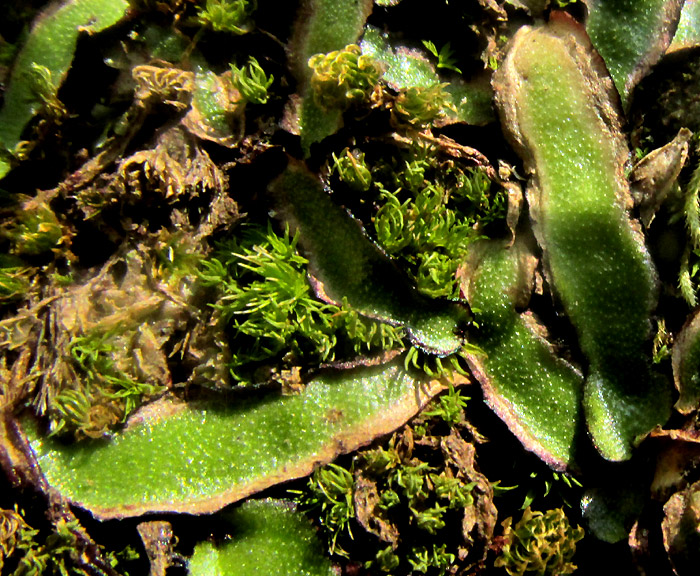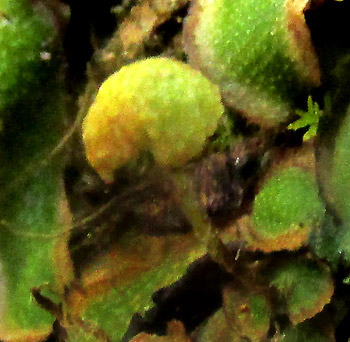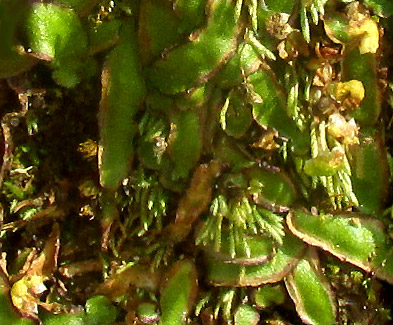Excerpts from Jim Conrad's
Naturalist Newsletter
Entry dated November 7, 2023, from notes taken near Cascadas de La Piedad waterfall 3kms NW of the community of San Pablo, municipality of Almeaco de Bonfil; bedrock of thick layers of compacted volcanic ash, or tuff; N20.1024°, W100.0019°, elevation 2360 meters (7750ft); extreme southern Querétaro state, MÉXICO
HEMISPHERIC LIVERWORT

The above community of ribbonlike thallose liverworts encrusted a usually-shaded vertical wall of compacted volcanic ash, in a washout of a gully eroding into an oak forest on a steep slope. At first glance it was very similar to other thallose liverworts found here, such as Marchantia cf. inflexa, met earlier on a similar usually-shaded vertical gully wall. Thalli of this current species, however, tended to range across the cliff's face for longer distances without forking, producing new thalli. Other thallose liverwort species as they elongate are more likely to bifurcate early in their development, then each fork forks again, on and on.

Closer up, thalli displayed thin, fragile, whitish edges turning light brown or purplish. Thallus surfaces were conspicuously speckled with air pores. Later I'd read that in this species the air pores are inconspicuous, but when highly magnified pictures of the species' pores were found, it was seen that the pores themselves were very small, but the thallus surface around the pores were covered with a kind of silvery sheen, or glaucescence, highlighting the pores presence at a distance. Also, our thialli's pores are not separated from one another by conspicuous lines connected to one another like cell walls, a feature seen on many species.

Liverwort identification can be hard to impossible without seeing the sexual organs. At first, the entire liverwort community seemed to produce only a single umbrella-like, spore-producing gynoecium, the one shown at the right. In that picture, notice that the gynoecium's hard-to-see stalk arises in a notch at the very tip of an elongating thallus, not back on the thallus's surface. That's significant, because the commonly occurring Plagiochasma rupestre similarly develops sparsely branching, elongate thalli, but its gynoecium stalks arise in mid-thallus. Species of the genus Asterella also are somewhat similar, but they develop a kind of toothy curtain, the pseudoperianth, hanging from the edges of its gynoecium lobes, which this species doesn't have.
Considering all the above details and after studying many images of thallose liverwort species known to exist in highland central Mexico -- especially noting our plant's long, seldom-branching thalli -- it became apparent that if our liverwort wasn't Plagiochasma rupestre, it needed to be Reboulia hemisphaerica. That was awkward, because Reboulia hemisphaerica produces beneath each of its gametophyte lobes a kind of capsule, which during much of its development looks like a tiny pea; later the capsule splits and releases spores. Our gametophyte photo seen above displays no such capsules, though maybe they'd be visible from below.
Looking more closely at enlarged parts of our high-resolution topmost picture, I began seeing more gametophytes.  For example, at the left, at the image's top, right corner, two faded gynoecia possibly bear something below their lobes. At the picture's lower, left, the impression is even stronger, one caplusle appearing already to have split into two sections.
For example, at the left, at the image's top, right corner, two faded gynoecia possibly bear something below their lobes. At the picture's lower, left, the impression is even stronger, one caplusle appearing already to have split into two sections.  And then there was the one at the right. That definitely shows the green umbrella top with pale capsules dangling below each lobe. Therefore: REBOULIA HEMISPHAERICA, in English usually named Hemispheric Liverwort.
And then there was the one at the right. That definitely shows the green umbrella top with pale capsules dangling below each lobe. Therefore: REBOULIA HEMISPHAERICA, in English usually named Hemispheric Liverwort.
Reboulia hemisphaerica is described as occupying soil on rocks that usually but not always are calcareous, such as limestone, in habitats that at least periodically are moist and temperate. They are "subcosmopolitan," meaning that they occur nearly everywhere on Earth where the species' habitat requirements are met, such as our temperate highlands of central Mexico.
Despite being subcosmopolitan, our Reboulia hemisphaerica currently is the only accepted species in its genus, and those pea-like capsules dangling beneath the umbrella lobes surely contribute to that.
I find no reported use of Reboulia hemisphaerica in traditional Mexican medicine, but the 2000 paper by CH Liao and others entitled "Antiplatelet effect of marchantinquinone, isolated from Reboulia hemisphaerica, in rabbit washed platelets," reported that our liverwort contains the compound marchantinquinone, which keeps blood platelets from clotting, thus is useful in keeping clots from forming during diseases such as atherosclerosis and restenosis. Our liverwort is used in Chinese folk medicine to treat skin blotches, external wounds and bruises.